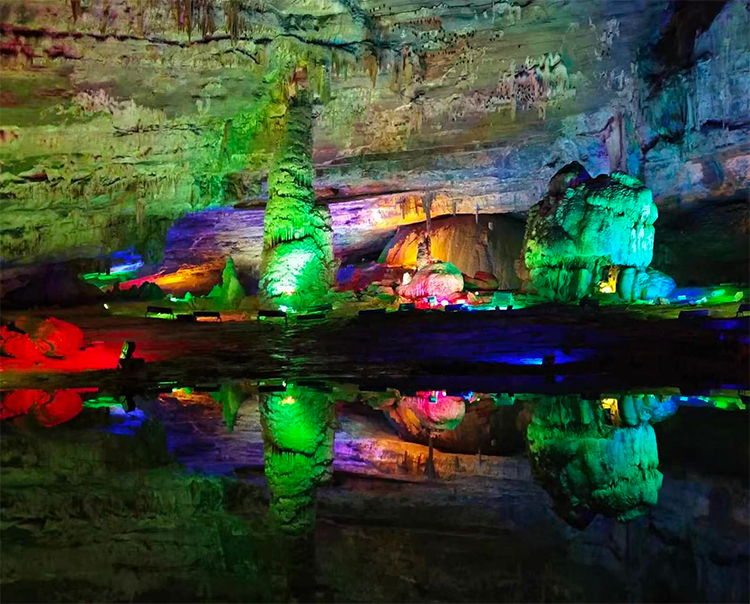Discover Dragon Palace: A 500-Million-Year Stalactite Cave in Jiangxi
Introduction
Imagine drifting by boat through a dim underground waterway and suddenly entering a soaring 30-meter “crystal palace”—stalactites hang like the Dragon King’s chandeliers, stalagmites pierce up like mythical pillars, and colored lights shimmer across the river. This is Longgong Cave (龙宫洞), also known as Dragon Palace Cave in Jiangxi: a 500-million-year-old karst masterpiece and one of the most spectacular caves in the Yangtze River basin. Whether you are a geology buff, a photography enthusiast, or a seeker of mysterious experiences, this time-traveling “Dragon Palace” adventure will be a highlight of your China visit.
1. World-class Karst Art Museum
“An underground dragon palace carved over eons”—the essence of Dragon Palace Cave lies in its well-preserved karst system. Formed in Cambrian limestone and sculpted by five hundred million years of water erosion and mineral deposition, the cave opens into a 1,600-meter-long fantasy corridor. The cave is divided into a dry-walk section and an underground river section: the dry zone can be explored on foot, revealing highlights like the “Dragon King’s Throne” and the “Coral Forest,” while the water zone requires a boat ride, where you encounter the “Anchoring Pillar”—a towering 20-meter stone column textured like coral that glows under lights like a mythical sea relic. Geologists call it a living classroom of sedimentation rates; most visitors simply call it China’s most beautiful underground palace.
2. A Journey Where Myth Meets Science
Legends of Dragon Palace Cave reach back to the Tang dynasty, when local fishermen believed a Dragon King governed the Yangtze watershed from inside the cave. Stone inscriptions at Longxian Temple record that villagers once performed rain rituals here during droughts. Modern research has found the cave hosts a unique microclimate: summer temperatures outside can be stifling while the cave remains a steady 18°C; in winter, rising water mist and refracted light create a “dragon-breath” effect. We recommend visiting in the rainy season (April–June), when the underground river swells and passing through the “Dragon Gate” waterway reveals haunting echoes of drops hitting stone—like the Dragon King’s low murmur.
3. Three-Dimensional Travel: Water, Land, and Air
Dragon Palace Cave caters to different visitor styles:
– Light sightseeing (1.5 hours): boat through the water passages → walk the dry core of the cave → visit Longxian Temple to make a wish. Ideal for families.
– Geological deep dive (3 hours): includes the science exhibit and cave-formation simulation area. Book ahead for an expert guide (Chinese and English available).
– Photography hotspots: the crystal-palace dome in the dry zone and the misty entrance to the water passage; a tripod is recommended.
The park has 70% barrier-free access; only the water-dock transfer has about 20 steps. Older visitors can take the electric shuttle (included with admission) right to the cave entrance.

4. Practical Visitor Information
– Getting there: 1.5 hours by car from Jiujiang city (navigate to “Longgong Cave Scenic Area”), or take the Pengze county tourist shuttle bus (one departure per hour).
– Tickets: Peak season (Apr–Oct) RMB 120 per person, including boat and shuttle; off-season RMB 80; students half price. Daily visitor limit 3,000—buy tickets in advance via the WeChat mini-program.
– Food & stay: The on-site “Longmen Inn” serves local specialties like Pengze steamed rice cakes and Poyang Lake fish. For upscale lodging, the Tianhong Town hot-spring hotel is 15 minutes away.
– Insider tip: On the second day of the second lunar month (Dragon’s Head Raising festival), the park holds a cave light show and folk performances—book at least a week in advance.

Conclusion
Dragon Palace Cave enchants because it satisfies both awe of natural forces and the romance of myth. When your fingertips brush rock laid down 500 million years ago, and your boat drifts beneath reflected, multicolored stalactites, you’ll understand why China National Geographic called it the ultimate karst romance. Don’t forget to ring the bronze bell at Longxian Temple—let its long, resonant tone carry your wish through this time-woven underground palace.


